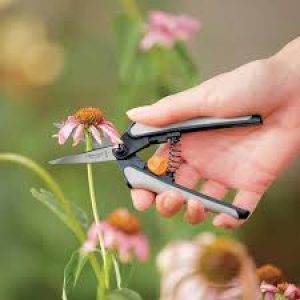by Joan Nieman-Agapas, Master Gardener, SCMG.
Does the thought of pruning make you anxious? Are you afraid to pick up those secateurs to tame that unruly shrub? Truly, all you need to do is master a few basic principles behind the WHY, WHEN, WHAT & HOW of pruning shrubs.
1.) WHY prune? What final outcome do you wish to achieve?
Pruning is done for some of the following reasons:
* Improve the plant’s shape & habit
* Enhance the plant’s appearance by removing dead, diseased or wayward shoots
* Rejuvenate or shorten an overgrown shrub
* Improve flowering &/or fruiting
* Encourage reblooming
WHEN should you prune? This depends on whether the shrub blooms on old or new wood.
What is OLD wood? Shrubs that bloom on old wood set flower buds for the next year as soon as the current year’s blooming is finished. Generally speaking, the earlier a plant blooms in spring, it most likely flowers on old wood. Plants that bloom on old wood should be pruned after flowering. Examples include: Azalea, Deutzia, Elderberry, Forsythia, Lilac, Ninebark, Pearl-bush, Quince, Spirea, Weigela.
What is NEW wood? Shrubs that bloom on new wood create buds for that year. Flower buds are present only in the current growing season. These plants can be pruned in spring before flowering.
Examples include: Bluebeard, Butterfly Bush, Coral berry, Diervilla (Bush Honeysuckle), Smooth Hydrangea, Panicle Hydrangea, Potentilla, Red-twig Dogwood, Rose of Sharon, Rose.
WHAT should be removed?
* Branches that touch the ground or a wall
* Deadwood – no green leaves on the branch right out to the tip
* Diseased branches or anything that rubs another branch
* Overlapping branches
* Redundant branches
* Clutter in the centre that contribute to bulk & impedes air circulation
HOW should you prune?
* Ensure your equipment is sharp & clean
* Remove no more that 1/3 of plant mass. You can achieve this one of two ways: cut back the entire plant evenly OR remove 1/3 of oldest wood at base of plant to encourage new, vigorous growth
* Make your cuts at a 45 degree angle
* Pause often to judge your progress from different angles.
* Walk around the entire shrub to ensure balance & symmetry.
* Prune from the bottom up & from the inside out
* Work in a roughly spiral fashion pruning up & out
* When in doubt – STOP. The job can be completed in a hour, a day or a week later. Tie ribbon or string to branches you think should be removed.
* When pruning, remember less is definitely more!!
Conclusion
After you have implemented these ideas & techniques, you will be rewarded with more flowers & healthier plants.
An excellent reference book with detailed illustrations is The Pruner’s Bible by Steve Bradley.
Next: watch for Matching Tools to the Pruning Task





